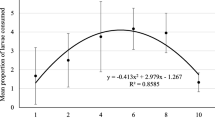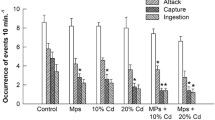Abstract
The influence of prey density, species and developmental stages on the predatory behaviour ofAmblyseius longispinosus (Evans) was studied. A 24 h exposure revealed that gravid females were more voracious compared to young females. The trends in the number of eggs and larvae consumed by each young and gravid female predator were about the same, showing an increase with density of the red and the yellow strains ofT. urticae levelling off at a prey density of 40 per predator. The highest mean number of eggs consumed in 24 h was 16.7 for the young female and 33.3 for the gravid female, and a mean high of 17 larvae in 24 h for the young female and 27.8 for the gravid female. With adult prey, however, the predators reached satiation point at a lower density of five to ten adult prey per female. In general, the response curves were adequately described by the Holling’s Type II model. Under continuous exposure for five days, a significant reduction in consumption was observed with the gravid female from the second day onwards, to a level similar to the number of eggs and larvae consumed by a young female predator.
Résumeé
L’influence de la densité des proies, du type de proie et du stade de développement sur le comportement prédateur d’Amblyseius longispinosus (Evans) a été étudiée. Une exposition de 24 h a montré que les femelles pleines d’œufs étaient plus voraces que les jeunes femelles. Le mode de consommation des œufs et des larves pour chaque jeune femelle et chaque femelle pleine était assez similaire en nombre, montrant un accroissement en relation avec la densité chez les souches « rouges » ou « jaunes « deTetranychus urticae, atteignant un palier pour une densité de 40 proies par prédateur. Le nombre moyen le plus élevé d’oeufs consommés en 24 h était de 16,7 pour les jeunes femelles et de 33,3 pour les femelles âgées; en moyenne les jeunes femelles consommaient 17 larves en 24 h et les femelles pleines 27,8 larves. Dans le cas de proies adultes cependant, les prédateurs atteignaient un niveau de satiété à une densité plus faible, de 5 à 10 adultes par femelle. En général, les courbes de réponse correspondaient exactement au modèle de Holling de type II. Si l’on exposait le prédateur à sa proie de manière continue pendant 5 jours, une réduction significative de la consommation était observée chez les femelles pleines à partir du deuxième jour, jusqu’à un niveau similaire au nombre d’œufs et de larves consommées par une jeune femelle prédatrice.
Similar content being viewed by others
References
Busvine, J. R. — 1980. Revised method for spider mites and their eggs. FAO method No. 10a. InRecommended Methods for Measurement of Pest Resistance to Pesticides. FAO Plant Production and Protection, Paper 21.
Charanasri, V. — 1994. Species and population density of predatory mites in durian orchards. InProc. 4th Int. Conf. Plt. Prot. Tropics, 1994 (A. Rajan & Y. B. Ibrahim eds.) 212–213.
Corpuz-Raros, L. A. — 1978. A Guide to Philippine Plant Mites — Guide to the Philippine Flora and Fauna II. U.P.N.S.R.C., DRB, Diliman, Quezon City, 270 pp.
Holling, C. S. — 1959. Some characteristics of simple types of predations and parasitism.Can. Entomol., 91, 293–320.
Hussey, N.W. &Scopes, N. — 1985. Biological Pest Control — The Glasshouse Experience.Buttler and Tanner Ltd., Frome and London, 239 pp.
Ibrahim, Y. B. &Palacio, V. B. — 1994. LIfe history and demography of the predatory mite,Amblyseius longispinosus Evans. —Expt. Appl. Acarol., 18, 361–369.
Ibrahim, Y. B. andKnowles, C. O. — 1986. Effects of formamidines on the population growth ofTetranychus urticae Koch. —Crop. Prot., 5, 411–416.
Ibrahim, Y. B. andSeo, W. M. — 1995. Behaviour of the predatory mite,Amblyseius longispinosus (Evans), on twospotted spider mite as prey (Acari: Phytoseiidae; Tetranychidae).Malay. Appl. Biol., 24, 67–72.
Mori, H. — 1969. The influence of prey density on the predation ofAmblyseius longispinosus. In:Proc. 2nd. Int. Congr. Acarol., 1967.
Sabelis, M. W. — 1981. Biological control of twospotted spider mites using phytoseiid predators. Part I: Modelling the preator-prey interaction at the individual level. Agri. Res. Report 910. Pudoc, Wageningen, The Netherlands, 242 pp.
Sabelis, M. W. — 1985. Predation of spider mites. In: Spider Mites, their Biology, Natural Enemies and Control. (Helle, W. &Sabelis, M.W. eds.)Elsevier, Amsterdam. Vol. 1B, pp. 103–129.
Van Lenteren, J. C. &Woets, J. — 1988. Biological and integrated control in greenhouses.Ann. Rev. Entomol., 33, 239–269.
Author information
Authors and Affiliations
Rights and permissions
About this article
Cite this article
Ibrahim, Y.B., Rahman, R.B.A. Influence of prey density, species and developmental stages on the predatory behaviour ofAmblyseius longispinosus (Acari: Phytoseiidae). BioControl 42, 319–327 (1997). https://doi.org/10.1007/BF02769824
Published:
Issue Date:
DOI: https://doi.org/10.1007/BF02769824




